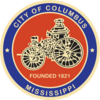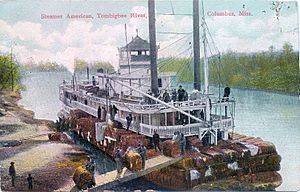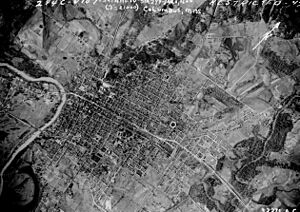Columbus, Mississippi facts for kids
Quick facts for kids
Columbus, Mississippi
|
|||
|---|---|---|---|
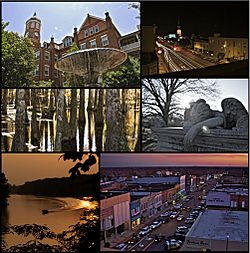
Montage of significant city locations
|
|||
|
|||
| Nickname(s):
Possum Town
|
|||
| Motto(s):
The Friendly City
|
|||
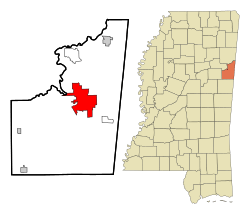
Location of Columbus, Mississippi
|
|||
| Country | United States | ||
| State | Mississippi | ||
| County | Lowndes | ||
| Founded | 1821 | ||
| Area | |||
| • Total | 25.88 sq mi (67.02 km2) | ||
| • Land | 25.05 sq mi (64.88 km2) | ||
| • Water | 0.83 sq mi (2.14 km2) | ||
| Elevation | 217 ft (66 m) | ||
| Population
(2020)
|
|||
| • Total | 24,084 | ||
| • Density | 961.48/sq mi (371.23/km2) | ||
| Time zone | UTC−6 (CST) | ||
| • Summer (DST) | UTC−5 (CDT) | ||
| ZIP codes |
39701-39705
|
||
| Area code(s) | 662 | ||
| FIPS code | 28-15380 | ||
| GNIS feature ID | 0668721 | ||
Columbus is a city in Mississippi, USA. It's the main city of Lowndes County. It sits on the eastern border of Mississippi, mostly near the Tombigbee River. This river is also part of the Tennessee-Tombigbee Waterway.
Columbus is about 146 miles (235 km) northeast of Jackson. It's also close to other cities like Meridian, Tupelo, Tuscaloosa, Alabama, and Birmingham.
In 2020, about 24,084 people lived in Columbus. It's the main city in the Columbus Micropolitan Area. Columbus is also part of "The Golden Triangle" region. This area includes Columbus, West Point, and Starkville. Important schools here are Mississippi University for Women and Mississippi School for Mathematics and Science.
Contents
History of Columbus
The first known visit to the Columbus area by Europeans was by explorer Hernando de Soto. He is thought to have crossed the nearby Tombigbee River long ago. The area became important in US history in 1810. That's when John Pitchlynn, a US agent for the Choctaw Native Americans, moved to Plymouth Bluff. He built a home and started a farm there.
After the Battle of New Orleans, Andrew Jackson saw a need for better roads. In 1817, he ordered a road built from Nashville to New Orleans. His surveyor chose a spot on the Tombigbee River for a ferry. This spot was good because the land was high on both sides. A military bridge was built where the current Tombigbee Bridge is now. This new road, called Jackson's Military Road, helped the area grow.
How Columbus Was Founded
Columbus was founded in 1819. People first thought it was in Alabama. So, Alabama officially recognized it as the Town of Columbus in December 1819. Before it became a town, locals called the area Possum Town. This name came from the local Choctaw and Chickasaw Native Americans. Possum Town is still the city's nickname today.
The town was settled where Jackson's Military Road crossed the Tombigbee River. In 1820, the post office moved to Columbus. A man named Silas McBee suggested the name Columbus. Because of his idea, a small local creek was named after him.
The city's founders quickly started a school called Franklin Academy. It is still open today and is known as Mississippi's first public school. At first, people thought Franklin Academy was in Alabama. But the border between Mississippi and Alabama was later corrected.
Columbus During the Civil War
During the American Civil War, Columbus was a hospital town. It also made gunpowder, handguns, and some cannons for the Confederate side. Because of this, the Union Army planned to invade Columbus. But Confederate General Nathan Bedford Forrest stopped them. Many soldiers injured in the Battle of Shiloh were brought to Columbus for care. Thousands were buried in the town's Friendship Cemetery.
One of the hospitals was at Annunciation Catholic Church, built in 1863. It is still a church today. On April 25, 1866, a group of ladies in Columbus decorated both Union and Confederate graves with flowers. This event was an early example of what became Memorial Day. A poet named Francis Miles Finch wrote a poem about it called "The Blue and the Grey".
Because General Forrest kept the Union Army away, Columbus's old homes were saved. They were not burned or destroyed. This means Columbus has many historic homes, second only to Natchez in Mississippi. You can tour these homes during the yearly Pilgrimage event.
When Union troops got close to Jackson, the state capital moved briefly to Columbus. It then moved to Macon.
Columbus in the 20th Century
Columbus has been home to Columbus Air Force Base (CAFB) since World War II. CAFB started as a flight training school. For a while in the 1950s and 1960s, it was a base for Strategic Air Command. Today, it is one of only four basic Air Force flight training bases in the US. It's special because pilots can experience regular flight conditions there.
In the mid-1900s, Columbus had many factories. These included the world's largest toilet seat maker, Sanderson Plumbing Products. There were also mattress, furniture, and textile plants. Most of these closed by 2000. Now, new factories near the Golden Triangle Regional Airport are helping the local economy. These include a Severstal steel mill, an American Eurocopter factory, and a Paccar engine plant.
Recent Events in Columbus
On June 12, 1990, a fireworks factory in Columbus exploded. The blast was felt up to 30 miles away. Two workers died in the explosion.
On February 16, 2001, strong winds damaged many homes and trees. Luckily, no one died. President George W. Bush declared the city a disaster area. On November 10, 2002, a tornado hit Columbus. It caused more damage, including to Mississippi University for Women.
In 2010, Columbus won a Great American Main Street Award. This award is for cities that work to preserve their historic downtown areas. In February 2019, a strong tornado hit Columbus. It caused a lot of damage to homes and businesses. Sadly, one woman died when a building fell on her.
Geography and Climate
Columbus is about 10 miles (16 km) west of the Mississippi-Alabama state line. You can reach it using U.S. Route 82 and U.S. Route 45. The city has a total area of about 22.3 square miles (57.8 square km). Most of this is land, with about 0.9 square miles (2.3 square km) of water.
Large rivers and lakes are nearby. The Buttahatchee River is to the north. The Luxapallila Creek runs through the city. The Tombigbee River is also here, with the John C. Stennis Lock and Dam forming Columbus Lake. Columbus is mostly flat in the northern part of Lowndes County. The land becomes rolling hills in the southern and eastern parts. This area is known for its prairies, forests, and floodplain forests.
Weather in Columbus
Columbus has a humid subtropical climate. This means it has hot, humid summers and mild winters.
| Climate data for Columbus, Mississippi (1991–2020 normals, extremes 1892–present) | |||||||||||||
|---|---|---|---|---|---|---|---|---|---|---|---|---|---|
| Month | Jan | Feb | Mar | Apr | May | Jun | Jul | Aug | Sep | Oct | Nov | Dec | Year |
| Record high °F (°C) | 84 (29) |
89 (32) |
93 (34) |
96 (36) |
100 (38) |
111 (44) |
109 (43) |
109 (43) |
110 (43) |
104 (40) |
90 (32) |
83 (28) |
111 (44) |
| Mean maximum °F (°C) | 72.9 (22.7) |
77.0 (25.0) |
83.7 (28.7) |
87.3 (30.7) |
93.0 (33.9) |
96.8 (36.0) |
98.8 (37.1) |
99.3 (37.4) |
95.5 (35.3) |
89.2 (31.8) |
80.3 (26.8) |
73.3 (22.9) |
100.8 (38.2) |
| Mean daily maximum °F (°C) | 55.8 (13.2) |
61.2 (16.2) |
69.7 (20.9) |
77.6 (25.3) |
84.9 (29.4) |
90.9 (32.7) |
93.8 (34.3) |
93.4 (34.1) |
88.4 (31.3) |
78.3 (25.7) |
66.5 (19.2) |
58.1 (14.5) |
76.5 (24.7) |
| Daily mean °F (°C) | 45.8 (7.7) |
50.2 (10.1) |
58.0 (14.4) |
65.5 (18.6) |
73.2 (22.9) |
80.2 (26.8) |
83.2 (28.4) |
82.6 (28.1) |
77.0 (25.0) |
66.2 (19.0) |
54.6 (12.6) |
48.1 (8.9) |
65.4 (18.6) |
| Mean daily minimum °F (°C) | 35.8 (2.1) |
39.2 (4.0) |
46.3 (7.9) |
53.3 (11.8) |
61.5 (16.4) |
69.4 (20.8) |
72.7 (22.6) |
71.9 (22.2) |
65.6 (18.7) |
54.0 (12.2) |
42.7 (5.9) |
38.1 (3.4) |
54.2 (12.3) |
| Mean minimum °F (°C) | 17.4 (−8.1) |
21.5 (−5.8) |
27.6 (−2.4) |
35.9 (2.2) |
45.7 (7.6) |
57.4 (14.1) |
64.5 (18.1) |
62.8 (17.1) |
49.4 (9.7) |
34.8 (1.6) |
26.1 (−3.3) |
21.4 (−5.9) |
15.7 (−9.1) |
| Record low °F (°C) | −7 (−22) |
−3 (−19) |
13 (−11) |
27 (−3) |
35 (2) |
42 (6) |
53 (12) |
50 (10) |
36 (2) |
24 (−4) |
9 (−13) |
−4 (−20) |
−7 (−22) |
| Average precipitation inches (mm) | 5.45 (138) |
5.69 (145) |
5.32 (135) |
5.81 (148) |
4.02 (102) |
4.40 (112) |
4.68 (119) |
4.50 (114) |
3.20 (81) |
3.63 (92) |
4.35 (110) |
5.59 (142) |
56.64 (1,439) |
| Average snowfall inches (cm) | 0.2 (0.51) |
0.2 (0.51) |
0.0 (0.0) |
0.0 (0.0) |
0.0 (0.0) |
0.0 (0.0) |
0.0 (0.0) |
0.0 (0.0) |
0.0 (0.0) |
0.0 (0.0) |
0.0 (0.0) |
0.0 (0.0) |
0.4 (1.0) |
| Average precipitation days (≥ 0.01 in) | 9.8 | 9.3 | 9.9 | 7.9 | 8.0 | 8.9 | 9.5 | 8.0 | 5.7 | 6.2 | 7.7 | 9.2 | 100.1 |
| Average snowy days (≥ 0.1 in) | 0.1 | 0.1 | 0.0 | 0.0 | 0.0 | 0.0 | 0.0 | 0.0 | 0.0 | 0.0 | 0.0 | 0.0 | 0.2 |
| Source: NOAA | |||||||||||||
People in Columbus
| Historical population | |||
|---|---|---|---|
| Census | Pop. | %± | |
| 1850 | 2,611 | — | |
| 1860 | 3,308 | 26.7% | |
| 1870 | 4,812 | 45.5% | |
| 1880 | 3,955 | −17.8% | |
| 1890 | 4,559 | 15.3% | |
| 1900 | 6,484 | 42.2% | |
| 1910 | 8,988 | 38.6% | |
| 1920 | 10,501 | 16.8% | |
| 1930 | 10,743 | 2.3% | |
| 1940 | 13,645 | 27.0% | |
| 1950 | 17,172 | 25.8% | |
| 1960 | 24,771 | 44.3% | |
| 1970 | 25,795 | 4.1% | |
| 1980 | 27,503 | 6.6% | |
| 1990 | 23,799 | −13.5% | |
| 2000 | 25,944 | 9.0% | |
| 2010 | 23,640 | −8.9% | |
| 2020 | 24,084 | 1.9% | |
| U.S. Decennial Census | |||
In 2020, there were 24,084 people living in Columbus. There were 9,572 households and 5,348 families.
Who Lives in Columbus?
| Race | Number | Percent |
|---|---|---|
| White | 7,460 | 30.97% |
| Black or African American | 15,345 | 63.71% |
| Native American | 37 | 0.15% |
| Asian | 250 | 1.04% |
| Pacific Islander | 4 | 0.02% |
| Other/Mixed | 350 | 2.2% |
| Hispanic or Latino | 458 | 1.9% |
In 2010, about 60% of the people were African American. About 37.4% were White. Other groups made up smaller parts of the population. About 1.4% of people were Hispanic or Latino.
Jobs and Economy
Columbus has several major employers. These include:
- Columbus Air Force Base
- Baptist Memorial Hospital - Golden Triangle
- Mississippi University for Women
- Columbus Municipal School District
- Lowndes County School District
- International Paper Columbus Mill
- Steel Dynamics, Inc. (a company that makes steel)
- Paccar (makes diesel engines)
- American Eurocopter (makes military aircraft)
- Baldor (makes electric motors)
- Nouryon (makes sodium chlorate)
- Aurora Flight Sciences (makes unmanned defense systems)
- Stark Aerospace (makes unmanned defense systems)
- Columbus / Nammo-Talley (defense systems)
- Valmet (makes paper machine parts)
Arts and Culture
Columbus is famous as the birthplace of playwright Tennessee Williams. His grandfather was a priest at St. Paul's Episcopal Church. Williams was born in the church's rectory on Main Street. Today, this building is the Tennessee Williams Home Museum and Welcome Center.
Education in Columbus
Columbus is home to a state university, the Mississippi University for Women. The university campus also hosts the Mississippi School for Mathematics and Science. This is a public boarding school for talented high school students.
The city's main public high school is Columbus High School. It's in the eastern part of town. It's the largest high school in the city. Columbus High School was formed in 1992 by combining two older high schools. Columbus also has the oldest public elementary school in Mississippi, Franklin Academy Elementary, founded in 1821.
The Lowndes County School District runs three high schools: Caledonia, New Hope, and West Lowndes. These schools are fed by elementary and middle schools with similar names.
Columbus also has several private schools:
- Columbus Christian Academy (K-3 through 12th grade)
- Heritage Academy (Christian, K-12)
- Annunciation Catholic School (Catholic, K-8)
- Victory Christian Academy (Christian, K-12)
- Palmer Home for Children (an orphanage)
Media and News
Columbus has local newspapers like the Commercial Dispatch and the Columbus Packet. There's also an online paper called Real Media.
The city has a TV station, WCBI-TV 4, which is a CBS channel. It also shows FOX and MyNetworkTV programs. Other TV stations from the Columbus / Tupelo / West Point area also serve the city.
Columbus also has several radio stations, playing different types of music and talk shows.
Transportation
Columbus is located on U.S. Highways 82 and 45. It also has several state highways. Columbus is the end point for the Columbus and Greenville Railway. Other railways like the BNSF Railway and Norfolk Southern also serve the city.
The local airport is Golden Triangle Regional Airport. It has flights to Atlanta.
The city is on the east bank of the Tombigbee River. The Luxapalila Creek flows through the town. This creek joins the Tombigbee River south of downtown.
Famous People from Columbus
- Henry Armstrong, world boxing champion
- Red Barber, sports commentator
- Corey Cott, actor and singer
- James E. Darnell, biologist
- Leslie Frazier, professional football player and coach
- Sam Jethroe, first black baseball player on the Boston Braves
- Stephen D. Lee, Confederate general and first president of Mississippi State University
- Jasmine Murray, singer and Miss Mississippi 2014
- Andre Rush, celebrity chef and veteran
- Jacob H. Sharp, lawyer and Confederate general
- Ruby Jane Smith, bluegrass fiddler
- Tennessee Williams, famous playwright
- Andrew Wood, musician
See also
 In Spanish: Columbus (Misisipi) para niños
In Spanish: Columbus (Misisipi) para niños



